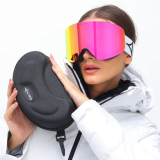Unlocking the potential of progressive lenses

Those who need vision correction at both near and far distances have three options. They can carry two pairs of glasses – one for near vision and the other for distance vision. Alternatively, they can go with bifocal lenses that have a visible line separation of two different power zones. However, those who want a more seamless experience can go with varifocal lenses (also known as progressive lenses) as they offer a smooth transition between near, intermediate, and far distances without any visual line separating different power zones. Nobody likes the hassle of carrying an extra pair of glasses everywhere they go; as it’s quite easy to forget it on important events. On the other hand, people also don’t prefer wearing bifocal lenses because they are more fashion-conscious. Bifocal lenses have a noticeable line separating the different vision areas, making them look awkward.
Varifocal lenses are different from bifocals as they don’t have any separate lines or segments, dividing the lens for distance and reading vision. These lenses have the distant vision part at the top, the intermediate vision part in the middle, and the near vision part at the bottom. The best part is that these lenses offer a smoother transition from one zone to another. They are similar to single-vision lenses in terms of appearance and it’s hard to notice any difference for others.
Since there is no distinct line demarcating the viewing zone, one might take some time to adapt to the transition. However, with advancements in technology, the process has become a lot more smoother these days. It hardly takes a couple of weeks to adjust to varifocal lenses and you can comfortably enjoy clear vision across all distances.
Who can wear progressive lenses?
Overall, those who need multiple prescriptions to perform various activities, such as driving, reading and other routine tasks can go for varifocal lenses. They offer vision correction for nearsightedness, farsightedness and astigmatism simultaneously. Also, those needing reading glasses or glasses for minute or detailed work due to Presbyopia can go with varifocal glasses. Presbyopia typically occurs at the age of 40 when individuals lack the potential to concentrate on near-vision objects. The maximum number of people who need to wear progressive lenses are diagnosed with Presbyopia.
Exploring the advantages of progressive lenses
Progressive lenses come with a variety of advantages, such as the following:
- You will have a clearer vision across all distances, which means you will be able to seamlessly switch between different perceptions.
- The transition will be more natural and gradual compared to other lens options, such as bifocals.
- From the fashion perspective, you will have a better experience while wearing varifocal lenses. They will look more pleasing because of the missing line.
Valuable tips for your new progressive lenses
The following tips might help you adapt to your progressive lenses faster:
- Patience is the key when wearing progressive lenses for the first time. You should expect to become fully comfortable after wearing them only after a few days.
- When you first try progressive lenses, refrain from using single-vision or old eyeglasses. If you do so, you will find it challenging to adapt to the transition process.
- Wear them for longer hours up to 2 weeks to get comfortable with the new progressive lenses.
- Anyone who has multiple prescriptions and is required to work on a computer will need to adjust the chair’s height with their sitting position. Doing so will help ease the strain caused by viewing across several distances.
- When you read something, try to adjust your eyes rather than your head.
Some essential things to remember while wearing your progressive lenses
As a new user of progressive lenses, you should position your varifocal glasses accurately, so that you can comfortably view everything. Another important point is to keep your nose as a pointer rather than moving your eyes from one side to another. This will prevent you from unnecessary eye strain and headaches. Lastly, you should take good care of yourself when driving or climbing the stairs until you get completely used to wearing progressive lenses.
Apart from these things, you should also be aware that a bit of eye strain is normal. But if you feel excessive tiredness in your eyes, you can wear them for two hours first, then for four hours and so on. The top area will focus on distant objects, the bottom area will emphasise reading prescriptions and the middle area will focus at intermediate distance. So, you must adjust your focus according to these parameters.
Get your progressive lenses with multiple prescriptions
You can choose varifocal lenses for a seamless transition between multiple vision corrections at the same time. It can be quite tricky to choose one eyewear brand among the several opticians. For affordable and premium varifocal lenses, you can visit Specscart physically or even place an order online. You may buy progressive or varifocal lenses handcrafted with accuracy per British standards and that too at modest prices. It offers progressive lenses with clear fully loaded lenses and free anti-reflective coatings. In addition, your varifocal lenses are also eligible for the digital blue light coating to block the harmful blue rays emitted through the screens.
Also Read:
Varifocal Glasses – Should you get them or not?
What is the difference between bifocal and varifocal lenses?


